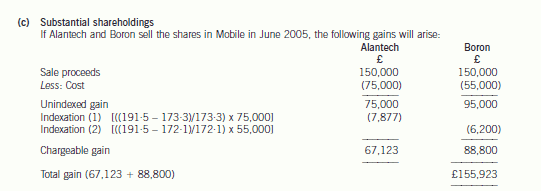ACCA F2知识点:目前比例活动比率的详解
发布时间:2021-02-14
很多ACCA考生对于ACCA考试比例活动比率不是很了解,接下来就和51题库考试学习网一起去了解下吧!
目前的比例
流动比率将年内到期的负债与现金余额进行比较,在年内将资产转换为现金。它评估公司履行其短期负债的能力。传统上,教科书告诉我们,这个比率应该超过2.0:1,以使公司能够安全地履行其责任。然而,各行业的可接受流动比率不尽相同,许多公司在2:1的水平以下安全运行。
非常高的电流比不一定好。这可能表明一家公司太流动了。现金通常被描述为一种“闲置资产”,因为它赚不到任何回报,携带太多现金被认为是浪费的。高比例也可能表明公司没有充分利用便宜的短期融资。
酸性测试
酸性测试(或快速比率)认识到库存通常需要很长时间才能转换成现金。因此它排除了流动资产的库存价值。传统上教科书告诉我们,这个比例应该超过1:1,但是许多成功的公司再次低于这个水平。
在实践中,公司的流动比率和酸性测试应与公司的经营现金流量一并考虑。健康的现金流量通常会弥补流动性比率的疲软。
活动比率
资产周转率:收入÷(非流动负债+权益总额)×365天
应收账款天数:应收账款÷信贷销售额×365天
库存天数:库存÷销售成本×365天
应付账款天数:应付账款÷采购(或销售成本)×365天
活动比率衡量组织将资产负债表项目转换为现金或销售额的能力。他们衡量企业管理资产的效率。
以上就是51题库考试学习网给大家分享的全部信息,希望能够帮到大家!后续请持续关注51题库考试学习网,51题库考试学习网将会为大家持续更新最新、最热的考试资讯!
下面小编为大家准备了 ACCA考试 的相关考题,供大家学习参考。
(c) Advise Alan on the proposed disposal of the shares in Mobile Ltd. Your answer should include calculations
of the potential capital gain, and explain any options available to Alan to reduce this tax liability. (7 marks)

However, an exemption from corporation tax exists for any gain arising when a trading company (or member of a trading
group) sells the whole or any part of a substantial shareholding in another trading company.
A substantial shareholding is one where the investing company holds 10% of the ordinary share capital and is beneficially
entitled to at least 10% of the
(i) profits available for distribution to equity holders and
(ii) assets of the company available for distribution to equity holders on a winding up.
In meeting the 10% test, shares owned by a chargeable gains group may be amalgamated. The 10% test must have been
met for a continuous 12 month period during the 2 years preceding the disposal.
The companies making the disposals must have been trading companies (or members of a trading group) throughout the
12 month period, as well as at the date of disposal. In addition, they must also be trading companies (or members of a trading
group) immediately after the disposal.
The exemption is given automatically, and acts to deny losses as well as eliminate gains.
While Alantech Ltd has owned its holding in Mobile Ltd for 33 months, its ownership of the Boron holding has only lasted
for 10 months (at 1 June 2005) since Boron was acquired on 1 July 2004. Selling the shares in June 2005 will fail the
12 month test, and the gain will become chargeable.
It would be better for the companies to wait for a further month until July 2005 before selling the amalgamated shareholding.
By doing so, they will both be able to take advantage of the substantial shareholdings relief, thereby saving tax of £29,625
assuming a corporation tax rate of 19%.
(iii) Explain the potential corporation tax (CT) implications of Tay Limited transferring work to Trent Limited,
and suggest how these can be minimised or eliminated. (3 marks)
(iii) Trading losses may not be carried forward where, within a period of three years there is both a change in the ownership
of a company and a major change in the nature or conduct of its trade. The transfer of work from Tay Limited to Trent
Limited is likely to constitute a major change in the nature or conduct of the latter’s trade. As a consequence, any tax
losses at the date of acquisition will be forfeited. Assuming losses were incurred uniformly in 2005, the tax losses at the
date of acquisition were £380,000 (300,000 + 2/3 x 120,000)). This is worth £114,000 assuming a corporation tax
rate of 30%.
Thus, Tay Limited should not consider transferring any trade to Trent Limited until after the third anniversary of the date
of the change of ownership i.e. not before 1 September 2008. As the trades are similar, there should be little problem
in transferring work from that date onwards.
Churchill Ice Cream has to date made two unsuccessful attempts to become an international company.
(d) What reasons would you suggest to explain this failure of Churchill Ice Cream to become an international
company? (5 marks)
(d) The two international strategies pursued to date are through organic growth (the stores in North America) and acquisition (the
companies in Germany and Italy). Neither seems to have worked. Here there seem to be some contradictions while global
tastes and lifestyles are argued to have developed – convergence of consumer tastes lies at the heart of this – but this does
not seem to have benefited Churchill. One questions the learning that these two unfortunate experiences have created. Of the
three core methods of achieving growth, namely organic, acquisition and joint venture, only joint venture remains to be tried.
The reasons for the international failures are clearly complex but one could argue that the strategy has been curiously na?ve.
Certainly, it has pursued a high-risk strategy. Exporting, perhaps through identifying a suitable partner, might create the
learning to lead to a more significant market entry. There is a need to understand local tastes; indeed the whole of the
marketing mix in the chosen market(s), and decide on appropriate strategy. A strategy based upon the acquisition of
companies and their consequent development represents a large investment of capital and requires considerable managerial
attention and expertise. Equally, the attempt to use the Churchill domestic format of opening its own stores creates both a
major financial commitment and the need to manage a radically different operation. One must seriously question whether
Churchill has these capabilities within a family-owned business. Clearly there are differences between the ice cream markets
in various countries, though the emergence of global brands suggests some convergence of tastes. Such differences reflect
differing cultures, tastes and competitive behaviour in each country. The lesson from Churchill’s international initiatives is that
national differences need to be carefully understood. There is little evidence that Churchill has understood these differencesor indeed learnt from them.
声明:本文内容由互联网用户自发贡献自行上传,本网站不拥有所有权,未作人工编辑处理,也不承担相关法律责任。如果您发现有涉嫌版权的内容,欢迎发送邮件至:contact@51tk.com 进行举报,并提供相关证据,工作人员会在5个工作日内联系你,一经查实,本站将立刻删除涉嫌侵权内容。
- 2021-02-14
- 2020-10-15
- 2020-10-15
- 2021-02-14
- 2021-02-14
- 2020-10-11
- 2020-10-11
- 2021-02-14
- 2020-10-15
- 2020-09-05
- 2020-10-15
- 2020-09-05
- 2021-03-05
- 2021-02-14
- 2020-10-11
- 2020-10-11
- 2020-10-15
- 2020-10-11
- 2021-02-14
- 2020-10-15
- 2021-04-08
- 2020-09-05
- 2020-10-11
- 2021-02-14
- 2020-10-11
- 2020-10-15
- 2021-02-14
- 2021-02-14
- 2021-04-02
- 2020-10-11